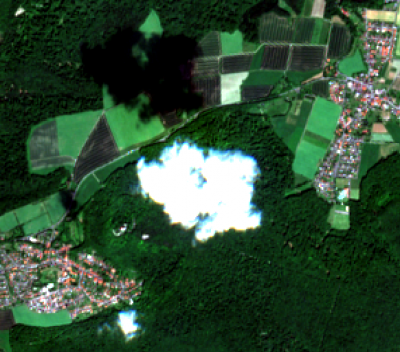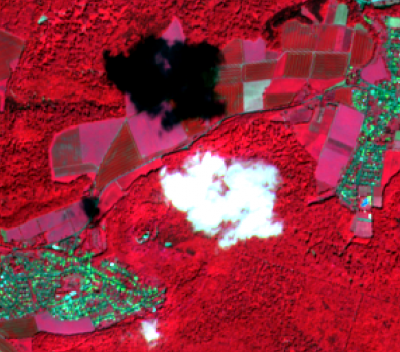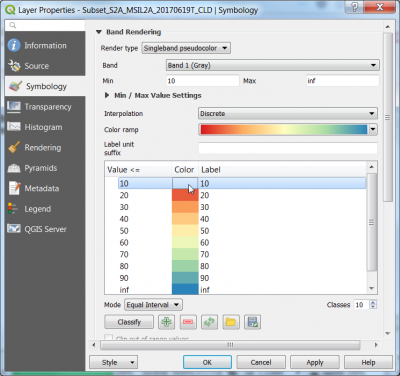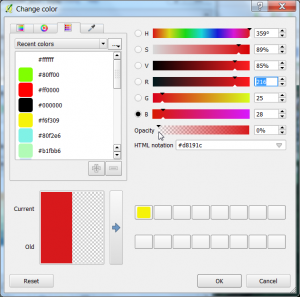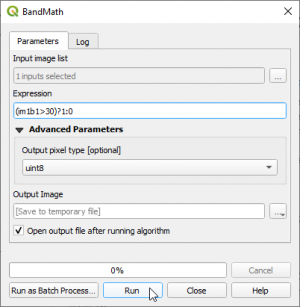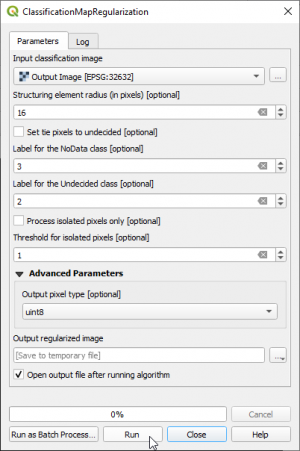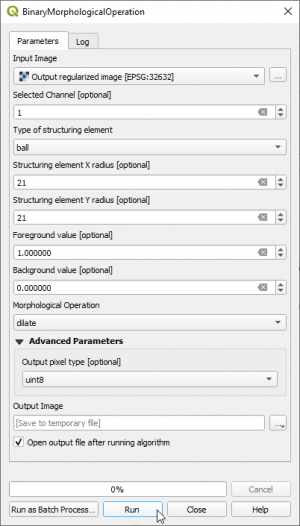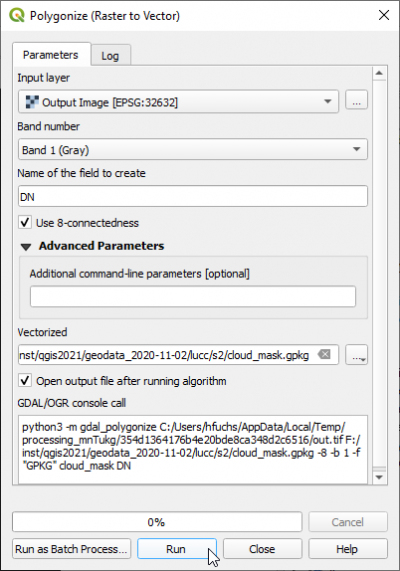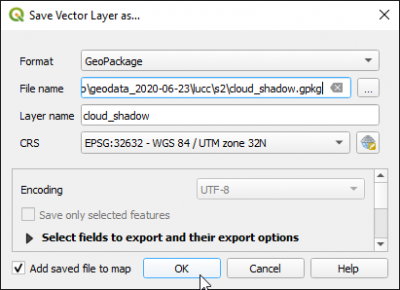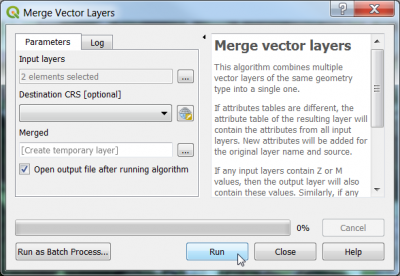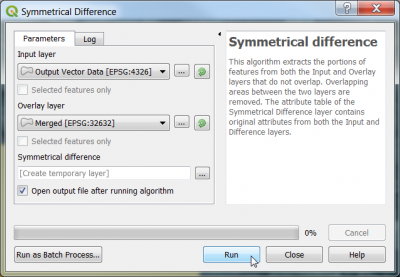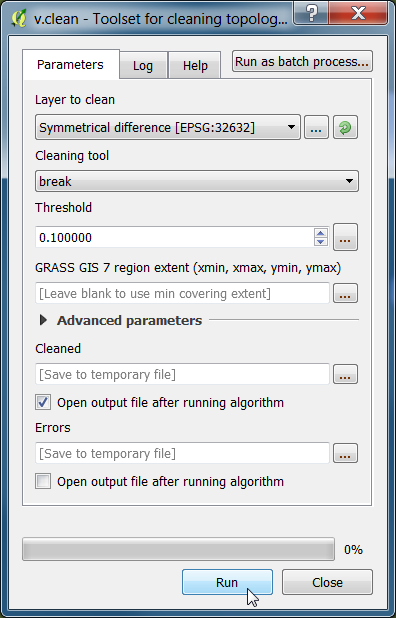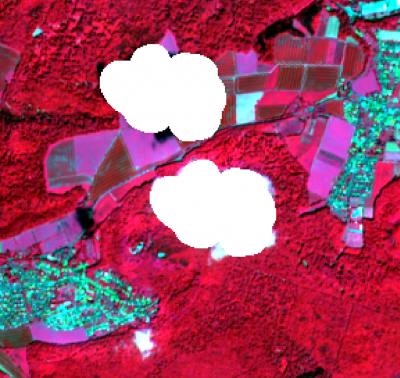Cloud masking
From AWF-Wiki
(Difference between revisions)
(→Refining cloud mask) |
(→Creating cloud shadow mask) |
||
| Line 24: | Line 24: | ||
= Creating cloud shadow mask = | = Creating cloud shadow mask = | ||
| − | + | * Prepare a False color composite of the Sentinel-2 image as background layer in the canvas. | |
| − | + | * Right click on the edited polygon layer in the [[TOC]]. Choose {{button|text= Save as...}}. Fill the form as shown below. | |
[[File:Qgis_vector_saveas.png|400px]] | [[File:Qgis_vector_saveas.png|400px]] | ||
| − | + | * Mark the new created polygon layer in the [[TOC]] and toggle editing [[File:Qgis_vector_edit.png]] of the vector file. Select all polygons using [[File:Qgis_vector_select_all.png|200px]] or press {{button|text=Ctrl + A}}. Activate {{button|text=Move features}} [[File:Qgis_vector_move.png]]. Left click on the canvas and move the cloud polygons that shadows on the background false color composite are completely covered. Save your edits [[File:Qgis_vector_save.png]]and stop editing [[File:Qgis_vector_edit.png]]. | |
| − | + | * Select polygons [[File:Qgis_vector_select.png]] outside the image extent of the false color composite and delete them by pressing {{button|text=Del}} on your keyboard. Save your edits and stop editing [[File:Qgis_vector_edit.png]]. | |
| − | + | ||
= Applying cloud and cloud shadow mask = | = Applying cloud and cloud shadow mask = | ||
Revision as of 15:18, 13 November 2017
Contents |
Sentinel-2 cloud mask
The exclusion of clouds and cloud shadow is an important processing step which is usually done in an early preprocessing stage. The Sentinel-2 products are annotated with Quality Indicators (QI_DATA). In the Level 2A product you may find a file in the folder QI_DATA with the extension _CLD_20m.jp2 (data type: 8bit unsigned integer, spatial resolution 20m) which might be used for masking clouds. The data range is from 0 for high confidence clear sky to 100 for high confidence cloudy (for more details see L2A Product Definition Document).
- Load a multiband Sentinel-2 satellite image (Level 2-A product) Changing Raster Layer Style to display a true color and a false color composite.
- Zoom in to a cloudy part of the image and compare the extent of cloud and cloud shadow in both composites. Which composite is better for displaying clouds?
- The original single band cloud quality indicator band is included in this specifc multiband file as band No. 13. Follow Split stack to extract this band.
- Overlay the QI Cloud band on top of the color composites. Use the Identify Feature Tool for requesting pixel values of the QI band file inside a cloud. Which values represent clouds?
- In (Layer Properties Style load Load the full data range (minimum/maximum values) ). Then change the Style to a Pseudocolor map with interpolation discrete and 10 equal interval classes as shown in the screenshot.
- Double click on a color field of some classes (Layer Properties Style) to open the change color window. Change the opacity from 100% to 0%. Find the best threshold for clouds.
Refining cloud mask
- Create a binary cloud mask (bitmask) where clouds = 1 and non-clouds = 0. Use the Processing tool Orfeo Toolbox --> Miscellaneous --> Band Math. Tick the single band QI layer in the Input Image list list. You may write a conditional ifelse expression using lazy operators. Type into the Expression field: (im1b1>30)?1:0. If pixel values of band 1 of multiband image 1 are larger than 30 then replace with 1 otherwise replace with 0. Mark the output layer in the TOC and click
 to stretch the histogram to view extents.
to stretch the histogram to view extents.
- Apply a circular majority filter with a radius of 7 pixels. Open the Processing tool SAGA Toolbox --> Raster filter --> Majority filter. The input Grid is the Output image of the band math operation step. Change the Search mode to Circle with an radius of 7 pixels. Mark the Filtered Grid in the TOC and click
 to stretch the histogram to view extents.
to stretch the histogram to view extents.
- Open the Processing tool Ordeo Toolboy --> Feature Extraction --> BinaryMorphologicalOperation (dilate). Choose the Filtered Grid as input image. The structuring element type is ball with a radius of 9 pixels. Mark the Feature Output Image in the TOC and click
 to stretch the histogram to view extents.
to stretch the histogram to view extents.
- Convert the Feature Output Imge from raster to vector format. Raster --> Conversion --> Polygonize. Select an output file name for vector polygons.
- Change the display of the output vector polygon layer Layer properties --> Style --> Single Symbol --> Simple Fill --> Fill Style from Solid to No Brush. Change the Outline color to bright green and increase the Outline width. As background layer use a False Color Composite of the Sentinel-2 image.
- Toggle editing
 of the resulting vector polygon layer. Activate Select polygons by dragging a box or by single click
of the resulting vector polygon layer. Activate Select polygons by dragging a box or by single click  , select all polygons which are misclassified as clouds and delete them by pressing Del on your keyboard. Save your edits
, select all polygons which are misclassified as clouds and delete them by pressing Del on your keyboard. Save your edits  .
.
Creating cloud shadow mask
- Prepare a False color composite of the Sentinel-2 image as background layer in the canvas.
- Right click on the edited polygon layer in the TOC. Choose Save as.... Fill the form as shown below.
- Mark the new created polygon layer in the TOC and toggle editing
 of the vector file. Select all polygons using
of the vector file. Select all polygons using  or press Ctrl + A. Activate Move features
or press Ctrl + A. Activate Move features  . Left click on the canvas and move the cloud polygons that shadows on the background false color composite are completely covered. Save your edits
. Left click on the canvas and move the cloud polygons that shadows on the background false color composite are completely covered. Save your edits  and stop editing
and stop editing  .
.
- Select polygons
 outside the image extent of the false color composite and delete them by pressing Del on your keyboard. Save your edits and stop editing
outside the image extent of the false color composite and delete them by pressing Del on your keyboard. Save your edits and stop editing  .
.
Applying cloud and cloud shadow mask
- Vector --> Data management tools --> Merge vector layers. as Layer to merge select the cloud and cloud_shadow polygon layers. Run.
- Create a polygon with the extent of the Sentinel-2 image: Create image extent polygon.
- Vector --> Geoprocessing Tools --> Symmetrical difference. Input layers are the image extent and the merged cloud and cloud_shadow polygons.
- Clean the output symmetrical difference vector file with Processing tools Grass GIS 7 --> vector --> v.clean.
- Apply the output vector layer Cleaned as mask to the multiband Sentinel-2 image file. See section Vector polygon masking in Spatial subset.
